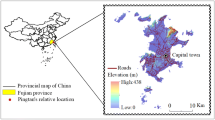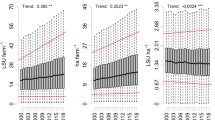Abstract
Discussions regarding the functional transformation of agricultural utilization and the mechanisms that underlie these changes within the Three Gorges Reservoir Area (TGRA) reflect variations in the relationship between people and their environment in China’s central and westerns part, an area of mountains and reservoirs. A clear understanding of these changes also provides the scientific basis for the development of multi-functional agriculture in typical mountainous areas. Five counties were selected for analysis in this study from the hinterland of the TGRA; we analyzed changes in farmland scaling and corresponding underlying mechanisms by defining the concepts of “Scaling Farmland” (SF) and by using the software packages ArcGIS10.2, SPSS, and Geographical Detectors. The results of this analysis show that sources of increased SF have mainly comprised cultivated and shrub land. Indeed, with the exception of some alpine off-season vegetables, SF growth has mainly occurred in low altitude areas and in places where the slope is less than 30°. We also show that spatial changes in various SF types have also been substantially different, but in all cases are closely related to road and township administrative centers. Natural factors at the patch level, including elevation and slope, have contributed significantly to SF, while at the township level, underlying socioeconomic and humanistic factors have tended to include road traffic and agricultural population density. In contrast, at the regional level, underlying driving forces within each have tended to be more significant than overall study area scale. We show that while changes in, and the development of, SF have been driven by numerous factors, agricultural policies have always been amongst the most important. The results clearly elucidate general land use transformation patterns within the mountain regions of western China.
Similar content being viewed by others
References
Abro Z A, Alemu B A, Hanjra M A, 2014. Policies for agricultural productivity growth and poverty reduction in rural Ethiopia. World Development, 59(3): 461–474.
Amjath-Babu T S, Kaechele H, 2015. Agricultural system transitions in selected Indian states: What do the related indicators say about the underlying biodiversity changes and economic trade-offs? Ecological Indicators, 57: 171–181.
Bartolini F, Viaggi D, 2013. The common agricultural policy and the determinants of changes in EU farm size. Land Use Policy, 31(2): 126–135.
Dai S Q, Wu B W, Wu S D et al., 2015. Priority research of hilly land consolidation based on land fragmentation and location condition: A case study of Songxi county, Fujian province. Journal of Guizhou Normal University (Natural Sciences), 33(4): 14–20. (in Chinese)
Dannenberg P, Kuemmerle T, 2010. Farm size and land use pattern changes in postsocialist Poland. Professional Geographer, 62(2): 197–210.
Defries R S, Asner G P, Houghton R A, 2004. Trade-offs in land-use decisions: Towards a framework for assessing multiple ecosystem responses to land-use change. Geophysical Monograph, 153: 1–9.
Driscoll J C, Kraay A C, 1998. Consistent covariance matrix estimation with spatially dependent panel data. Review of Economics and Statistics, 80(4): 549–560.
Dong X J, Tang H J, 2015. A review on the scale operation of farmland worldwide. Chinese Journal of Agricultural Resources and Regional Planning, 36(3): 62–71. (in Chinese)
Foley J A, Defries R, Asner G P et al., 2005. Global consequences of land use. Science, 309(5734): 570–574.
Grashof-Bokdam C J, Cormont A, Polman N B P et al., 2016. Modelling shifts between mono-and multifunctional farming systems: The importance of social and economic drivers. Landscape Ecology, 32(3): 1–13.
Guo B, Jin X, Yang X et al., 2015. Determining the effects of land consolidation on the multifunctionlity of the cropland production system in China using a SPA-fuzzy assessment model. European Journal of Agronomy, 63: 12–26.
Herdt R W, Mandac A M, 1981. Modern technology and economic efficiency of Philippine rice farmers. Economic Development and Cultural Change, 29(2): 375–399.
̐lkay U G, Štefan B, 2015. Farm size and participation in agri-environmental measures: Farm-level evidence from Slovenia. Land Use Policy, 46: 273–282.
Jayne T S, Chamberlin J, Traub L et al., 2011. Africa’s changing farm size distribution patterns: The rise of medium-scale farms. Agricultural Economics, 47(Suppl.1): 197–214.
Lambin E F, Meyfroidt P, 2011. Global land use change, economic globalization, and the looming land scarcity. Proceedings of the National Academy of sciences of the United States of America, 108: 3465–3472.
Liu J Y, Kuang W H, Zhang Z X et al., 2014. Spatiotemporal characteristics, patterns and causes of land use changes in China since the late 1980s. Journal of Geographical Sciences, 24(2): 195–210.
Liu Y, Song W, Deng X, 2016. Changes in crop type distribution in Zhangye City of the Heihe River Basin, China. Applied Geography, 76: 22–36.
Liu Y S, Fang C L, 2001. A study on regional forced land use conversion and optimal allocation: Taking the Three Gorges Reservoir Area as an example. Journal of Natural Resources, 16(4): 334–340. (in Chinese)
Long H L, Liu Y S, Li X B et al., 2010. Building new countryside in China: A geographical perspective. Land Use Policy, 27(2): 457–470.
Meng Q H, Fu B J, Yang L Z, 2010. Effects of land use on soil erosion and nutrient loss in the Three Gorges Reservoir Area, China. Soil Use & Management, 17(4): 288–291.
Moran W, 1997. Farm size change in New Zealand. New Zealand Geographer, 53(1): 3–13.
Niroula G S, Thapa G B, 2005. Impacts and causes of land fragmentation, and lessons learned from land consolidation in South Asia. Land Use Policy, 22(4): 358–372.
Petit M, Weiss C, Heckelei T et al., 2011. Success in agricultural transformation: What it means and what makes it happen. European Review of Agricultural Economics, 39(5): 882–884.
Rgjr P, Schneider L C, 2001. Land-cover change model validation by an ROC method for the Ipswich watershed, Massachusetts, USA. Agriculture Ecosystems & Environment, 85(1): 239–248.
Shao J A, Dang Y F, Wang W et al., 2018. Simulation of future land-use scenarios in the Three Gorges Reservoir Region under the effects of multiple factors. Journal of Geographical Sciences, 28(12): 1907–1932.
Su S, Zhou X, Wan C et al., 2016. Land use changes to cash crop plantations: Crop types, multilevel determinants and policy implications. Land Use Policy, 50: 379–389.
Tan M, Robinson G M, Li X et al., 2013. Spatial and temporal variability of farm size in China in context of rapid urbanization. Chinese Geographical Science, 23(5): 607–619.
Tang J Y, Zeng F S, 2014. The proper scale management of farmland: Types, performance and revelation: A case study of Hunan Province. Economic Geography, 34(5): 134–138. (in Chinese)
Wang J, Chen K Z, Gupta S D et al., 2015. Is small still beautiful? A comparative study of rice farm size and productivity in China and India. China Agricultural Economic Review, 7(3): 484–509.
Wang J F, Hu Y, 2012. Environmental health risk detection with GeogDetector. Environmental Modelling & Software, 33(10): 114–115.
Wang J F, Li X H, Christakos G et al., 2010. Geographical detectors-based health risk assessment and its application in the neural tube defects study of the Heshun region, China. International Journal of Geographical Information Science, 24(1): 107–127.
Wang J F, Zhang T L, Fu B J, 2016. A measure of spatial stratified heterogeneity. Ecological Indicators, 67: 250–256.
Wu G P, Zeng Y N, Xiao P F et al., 2010. Using autologistic spatial models to simulate the distribution of land-use patterns in Zhangjiajie, Hunan Province. Journal of Geographical Sciences, 20(2): 310–320.
Xu Q, Yin R L, 2010. Literature review on the issues of proper scale management of farmland in China. China Land Science, 24(4): 75–80. (in Chinese)
Yang P, Wang L, Zhang N et al., 2016. Family farms’ scale at home and abroad. Chinese Agricultural Science Bulletin, 14: 200–204. (in Chinese)
Yang Q Y, Xin G X, Shi Y et al., 2009. Study on the scale of rural-land management in Chongqing. Journal of Southwest University (Natural Science Edition), 31(4): 143–147. (in Chinese)
You H, 2017. Agricultural landscape dynamics in response to economic transition: Comparisons between different spatial planning zones in Ningbo region, China. Land Use Policy, 61: 316–328.
Zhou Y, Tu J J, Lu D B et al., 2011. Study on the relationship between population and economic spatial distribution and its dynamic in Chongqing. Economic Geography, 31(11): 1781–1785. (in Chinese)
Author information
Authors and Affiliations
Corresponding author
Additional information
Foundation: Key Basic Science and Cutting Edge Technology Research Plan of Chongqing, No.cstc2015jcyjBX0128; National Natural Science Foundation of China, No.41261045; Chongqing Normal University Graduate Student Research Innovation Project, No.YKC18033
Rights and permissions
About this article
Cite this article
Liang, X., Li, Y. Spatiotemporal features of farmland scaling and the mechanisms that underlie these changes within the Three Gorges Reservoir Area. J. Geogr. Sci. 29, 563–580 (2019). https://doi.org/10.1007/s11442-019-1615-0
Received:
Accepted:
Published:
Issue Date:
DOI: https://doi.org/10.1007/s11442-019-1615-0




